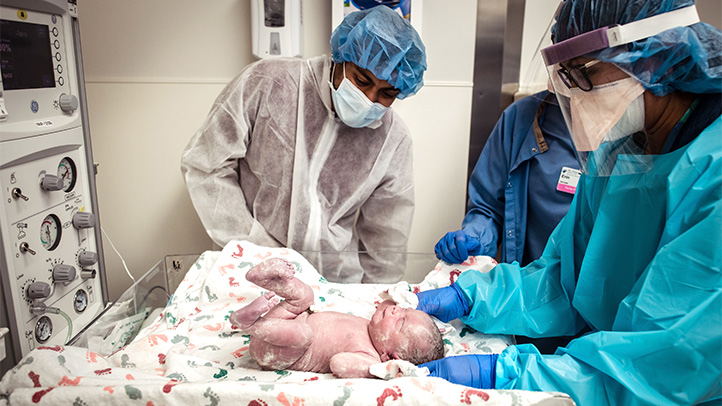As babies make their way out into the world during a vaginal birth, they take a trip through the birth canal, where they’re coated in mostly-healthy bacteria. This bacteria contributes to their microbiomes — the collection of bacteria that inhabit the body — that then help their gut and immune system develop.
But the approximately 1 in 3 babies in the U.S.[1] who are born through cesarean section (C-section) don’t get this initial dose of vaginal bacteria — which some experts think could be one possible reason why babies born via C-section also tend to have higher rates of asthma and allergies.
This has led some parents to try something new: swabbing their newborn with Mom’s vaginal fluids just after delivery, a procedure known as vaginal seeding. But the jury’s still out on just how beneficial — not to mention safe — this practice is, and leading expert groups don’t currently recommend it.
What is vaginal seeding?
Vaginal seeding involves wiping a newborn’s mouth, nose or skin with their mother’s vaginal fluids after a C-section. It was first performed by New York University researchers during a 2016 pilot study on the microbiome published in the journal Nature Medicine.[2]
Some experts believe the absence of certain types of bacteria in the microbiomes of C-section babies could partly explain why they’re more prone to conditions such as asthma. In theory, exposing babies to some beneficial bacteria from their mother could help boost their immunity and help them get a healthier start in life.
However, researchers are just beginning to understand how a newborn’s microbiome gets established. For example, while some research has shown that the gut bacteria in newborns delivered through Cesarean section are different from those of babies who were born vaginally, this could also be because their mothers are treated with antibiotics during delivery. It’s also difficult to compare the microbiota of all C-section babies because some littles ones are born after their mother’s water has broken, which would expose them to some bacteria, while others are delivered before that happens.
Read This Next
As a result, due to limited data and the possible risks of vaginal seeding, the American College of Obstetricians and Gynecologists (AGOG) doesn’t currently recommend (or even support) the procedure outside of a research setting.[3]
How does vaginal seeding work?
Since leading experts such as ACOG don’t support vaginal seeding, there’s no one method that scientists or doctors have settled on to expose babies to vaginal bacteria.
In a research setting, though, a health care provider would typically insert a piece of gauze into the mother’s vagina about an hour before the scheduled C-section. This gauze would then be removed before the surgery. After delivery, a newborn’s body — including her face and mouth — would be swabbed with this gauze.[4]
Are there any benefits to vaginal seeding?
In the 2016 Nature Medicine pilot study, researchers found that infants born via C-section who were then exposed to vaginal seeding had a microbiome that resembled those of babies who were delivered vaginally for the first few weeks of life.
But this study was extremely small and limited: Vaginal seeding was only performed on four of the infants in the study, and researchers didn’t continue tracking the microbiome after 30 days. For this reason, ACOG stresses that larger and longer-term studies are essential in order to determine if vaginal seeding offers real benefits.
Researchers hope that future studies will show that vaginal seeding of babies born through C-sections decreases their risks of asthma, hay fever, food allergies and perhaps even obesity. But much more research is needed.
Plus, all babies are also quickly exposed to bacteria from their parents' bodies as they snuggle and eat, so it’s unclear if vaginal seeding would offer any additional benefits.
What are the potential risks of vaginal seeding?
As more parents-to-be are learning about vaginal seeding, they’re starting to ask their health care practitioners about the procedure. But doctors caution that it’s too early to recommend vaginal seeding in a hospital setting.
Not only are there no studies that show any long-term benefits of exposing C-section babies to vaginal fluids, but the procedure could expose babies to unwanted bacteria, including herpes, syphilis and group B strep. These infections — even when mild in an adult — can cause severe symptoms and permanent damage to infants.
In the studies being done currently, mothers are tested to make sure they don’t have any infections that they could transmit to their babies. If these tests aren’t done, seeding could put C-section babies at unnecessary risk.
Other ways to give your baby a healthy microbiome
Vaginal seeding isn’t the only way to transfer healthy bacteria to your baby. Since beneficial microbes live on your skin, lots of skin-to-skin contact with your little one is important too.
Breastfeeding can also help support your baby’s microbiome, since healthy microbes live in breast milk. Lastly, it’s important to only use antibiotics when absolutely necessary. Antibiotic overuse can be dangerous, and these medications can kill off both good and bad gut bacteria, which may cause changes to the microbiome.





 Trending On What to Expect
Trending On What to Expect






